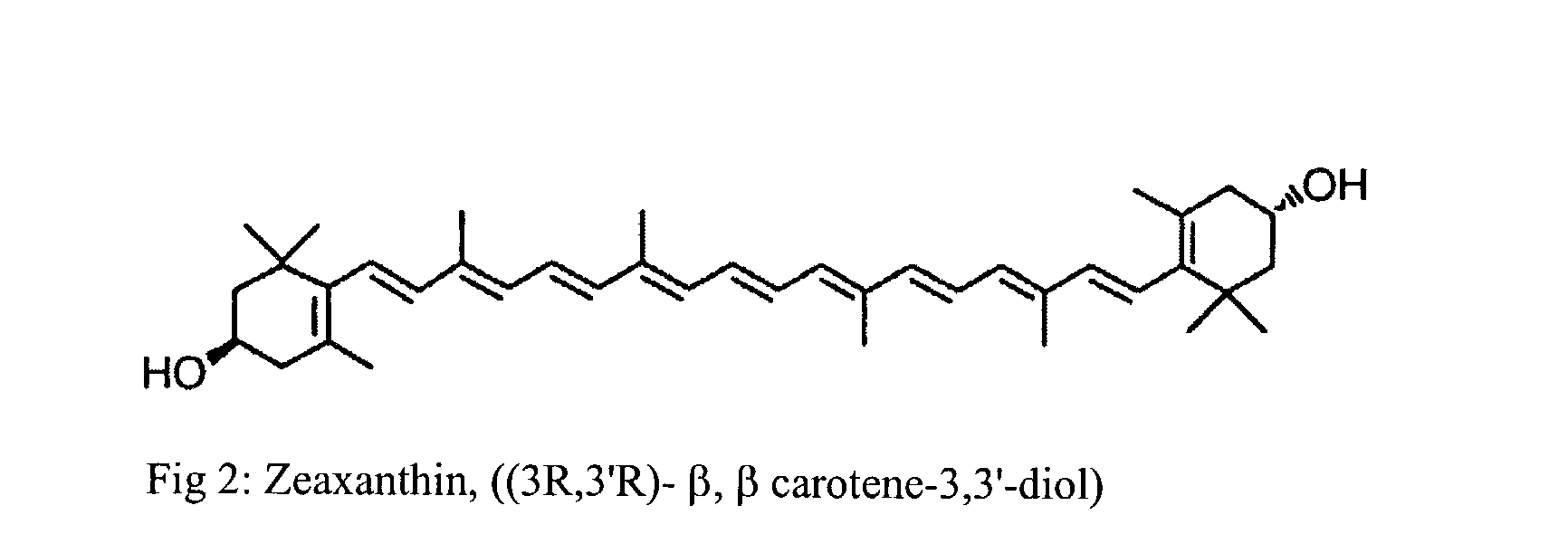Process for the preparation of xanthophyll crystals
a technology of xanthophyll and crystals, which is applied in the field of process for the preparation of xanthophyll crystals, can solve the problems of difficult and confusing for difficulty and confusion among analysts, manufacturers and traders, etc., and achieves the effects of cost-effectiveness, simple, convenient, economical and commercially feasible, and high purity
- Summary
- Abstract
- Description
- Claims
- Application Information
AI Technical Summary
Benefits of technology
Problems solved by technology
Method used
Image
Examples
example 2
[0088] Commercial grade marigold oleoresin (56.3 g) containing 11.82% xanthophyll content (by spectrophotometric method) was mixed with potassium isopropyl alcoholate (prepared by dissolving 14 g potassium hydroxide in 170 ml isopropanol.) The saponification mixture was heated and maintained at 70 .degree. C. for a period of 3 hours. The degree of hydrolysis was monitored by HPLC during the saponification stage. Isopropanol was distilled off under reduced pressure and the solids obtained were stirred with 225 ml of water at room temperature. The mixture was taken into a separatory funnel and extracted with equal volume of ethyl acetate(3 times). Ethyl acetate layer was collected and washed with distilled water for removing the excess alkali, soapy materials and other water-soluble impurities. The ethyl acetate layer was distilled off under reduced pressure to get saponified crude extract (22.21 g)
[0089] This crude extract (22.21 g) was subjected to purification by stirring with 90 m...
example 3
[0091] Commercial grade marigold oleoresin (51.60 g) containing 11.82% xanthophyll content ( by spectrophotometric method) was mixed with potassium isopropyl alcoholate (prepared by dissolving 12.90 g potassium hydroxide in 155 ml isopropanol ). The saponification mixture was heated maintained at 70 .degree. C. for a period of 3 hours. The degree of hydrolysis was monitored by HPLC during the saponification stage. Isopropanol was distilled off under reduced pressure and the solids obtained were stirred with 206 ml of water(with 5% sodium sulphate) at room temperature. The mixture was taken into a separatory funnel and extracted with equal volume of ethyl acetate(3 times). Ethyl acetate layer was collected and washed with distilled water for removing the excess alkali, soapy materials and other water-soluble impurities. The ethyl acetate layer was distilled off under reduced pressure to get saponified crude extract (21.80 g)
[0092] This crude extract (21.80 g) was subjected to purific...
example 4
[0094] Commercial grade marigold oleoresin (50.0 g) containing 11.82% xanthophyll content ( by spectrophotometric method) was mixed with potassium isopropyl alcoholate (prepared by dissolving 12.50 g potassium hydroxide in 150 ml isopropanol). The saponification mixture was heated and maintained at 70 .degree. C. for a period of 3 hours. The degree of hydrolysis was monitored by HPLC during the saponification stage. Isopropanol was distilled off under reduced pressure and the solids obtained were stirred with 200 ml of water(with 5% sodium sulphate) at room temperature. The mixture was taken into a separatory funnel and extracted with equal volume of ethyl acetate(4 times). Ethyl acetate layer was collected and washed with distilled water for removing the excess alkali, soapy materials and other water-soluble impurities. The ethyl acetate layer was distilled off under reduced pressure to get saponified crude extract (21.70 g)
[0095] This crude extract (21.70 g) was subjected to purif...
PUM
| Property | Measurement | Unit |
|---|---|---|
| temperature | aaaaa | aaaaa |
| temperature | aaaaa | aaaaa |
| temperatures | aaaaa | aaaaa |
Abstract
Description
Claims
Application Information
 Login to View More
Login to View More - R&D
- Intellectual Property
- Life Sciences
- Materials
- Tech Scout
- Unparalleled Data Quality
- Higher Quality Content
- 60% Fewer Hallucinations
Browse by: Latest US Patents, China's latest patents, Technical Efficacy Thesaurus, Application Domain, Technology Topic, Popular Technical Reports.
© 2025 PatSnap. All rights reserved.Legal|Privacy policy|Modern Slavery Act Transparency Statement|Sitemap|About US| Contact US: help@patsnap.com


